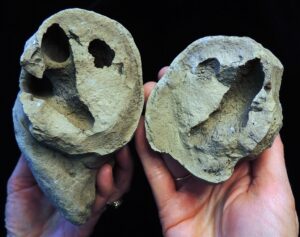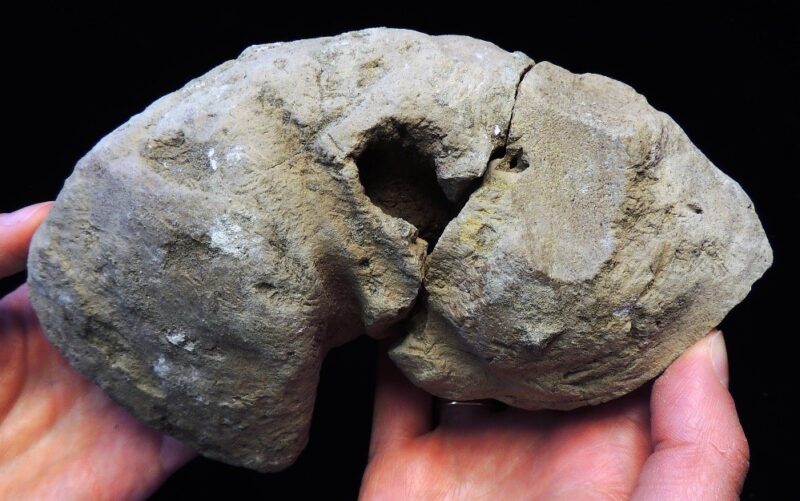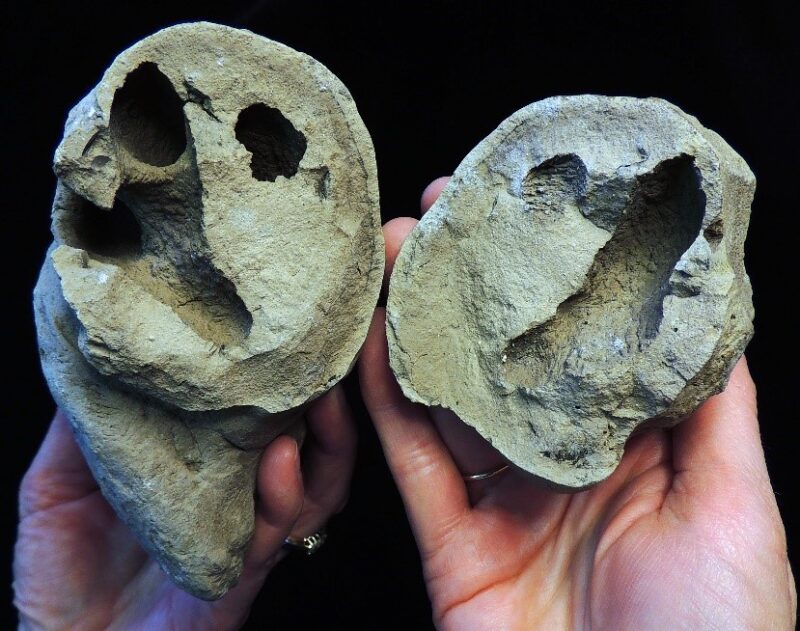 Although we find it repulsive, there are animals that eat feces! Furthermore, if conditions are just right, feces can fossilize, and when they do, they are known as coprolites. Some coprolites preserve evidence that they were partially eaten. Nibbled or burrowed coprolites have been found along Calvert Cliffs, the world-famous cliffs along part of the western shore of Chesapeake Bay that preserve 8 – 20 million-year-old fossils mostly from the marine realm.
Although we find it repulsive, there are animals that eat feces! Furthermore, if conditions are just right, feces can fossilize, and when they do, they are known as coprolites. Some coprolites preserve evidence that they were partially eaten. Nibbled or burrowed coprolites have been found along Calvert Cliffs, the world-famous cliffs along part of the western shore of Chesapeake Bay that preserve 8 – 20 million-year-old fossils mostly from the marine realm.
There are basically two kinds of fossils, body fossils (like shells, bones, and teeth; the fossilized remains of a once-living organism) and trace fossils (like footprints, nests, burrows, and coprolites…evidence of the activities of a once-living organism).
Scientific names, consisting of a genus and species name, are given to body fossils, like one of the most famous ones, Tyrannosaurus rex. Scientific names can also be given to trace fossils; they are referred to as ichnotaxonomic names (hence ichnogenera and ichnospecies). “Ichnos” means “footprint” in Greek.
In a paper just published open access in the Swiss Journal of Palaeontology (https://trebuchet.public.springernature.app/get_content/ecc36f9a-335f-4775-ac47-44817d7262b2), Calvert Marine Museum Curator of Paleontology, Dr. Stephen J. Godfrey in collaboration with Dr. Alberto Collareta, Università di Pisa, in Italy, have given an ichnotaxonomic name to burrows that occur within large coprolites preserved along Calvert Cliffs.
The new ichnotaxonomic name is Transexcrementum cuniculus, Latin for “tunnel that goes through feces”. This scientific name is applied to tubular (cylindrical) tunnelings in coprolites (Figures 1 and 2). The coprolites themselves are trace fossils, being the evidence of the activity of once-living animals. The burrows are also trace fossils, being the feeding/tunneling activity of once-living animals, but by an as yet unknown kind (or kinds) of organism(s). Because these trace fossils (the burrows) occur within another kind of trace fossil (the fossilized feces), this compound fossil is known as a complex trace fossil. Although we don’t know for sure what kind of animal produced the original feces, they are most similar to coprolites produced by crocodilians, and from their fossilized bones and teeth, we know that there were large marine crocodiles living in this area during the Miocene epoch.
The burrows often curve around within the coprolite. This suggests that the tunneling organims were not just trying to dig straight through the feces. Rather, the curved burrows suggest that the tunneling tracemaker likely engaged in coprophagy; the term given to animals that eat feces. Not only were the coprolites burrowed, but the outside of the feces is often heavily marked with short and irregularly oriented scratches and gouges (Figure 3). These marking were either made by the feeding animal’s mouth-parts or its feeding appendages, like claws.
Judging from the overall rarity of Transexcrementum cuniculus occurrences in the fossil record, the tracemaker responsible for the burrows might also have been rare, or fed on feces only occasionally. In a way, it is remarkable that these burrows were preserved at all. The vast, vast majority of feces did not fossilized, they were simply recycled into the ancient ecosystm as they are today.
Explore how the prehistoric past, natural environments, and maritime heritage come to life and tell a unique story of the Chesapeake Bay. The Calvert Marine Museum is open daily from 10 a.m. to 5 p.m. Admission is $9.00 for adults; $7.00 for seniors, military with valid I.D, AAA and AARP members; $4.00 for children ages 5 – 12; children under 5 and museum members are admitted free.

Figure 1. A large, probably crocodilian coprolite (fossilized feces) from Calvert Cliffs, Maryland, U.S.A., showing a subcircular opening made by a tunneling organism as it ate its way into the feces before it was fossilized.

Figure 2. The same coprolite seen in Figure 1, opened up where it broke, showing the curving burrows within made by an unknown kind of animal, that was likely eating the feces as it went.

Figure 3. The outer surface of another coprolite from Calvert Cliffs showing the linear gouges made by one or more animals as they fed on the fecal mass before it fossilized.


